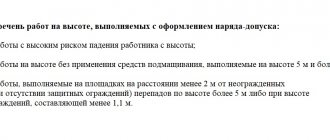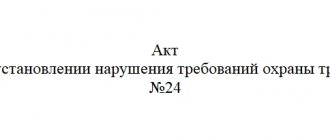Occupational safety implies established regulatory measures aimed at ensuring safety and preserving the life and health of personnel. It includes a set of procedures, such as checking the correct use of safe work practices, the use of protective equipment, compliance with the rules for using tools and devices, as well as checking the technical condition of premises, buildings, and the workplace for compliance with established labor protection requirements. The basic rules depend on the specifics of enterprises and are prescribed in the Labor Code of the Russian Federation (hereinafter referred to as the Labor Code of the Russian Federation). Occupational safety audit identifies possible violations.
Employer Responsibilities
The employer is obliged to develop internal documents, regularly conduct briefings, test knowledge, and inform employees about factors ensuring safety.
The employer is obliged to create a safe environment:
- use equipment that meets standards, repair and maintain it on time;
- equip premises in accordance with fire and electrical safety rules;
- install protective devices and structures;
- provide lighting, ventilation, maintain a comfortable temperature;
- dispose of waste in a timely manner;
- provide staff with special clothing, SOS and PPE, instructions and visual materials;
- create an alarm system, place safety signs;
- organize training of workers on labor protection;
- take measures to preserve the health and life of workers in the event of emergency situations, take measures to prevent them;
- carry out SOUT (special assessment of working conditions) at workplaces.
OCCUPATIONAL SAFETY INSTRUCTIONS
If the employer does not provide instructions, this may entail liability under Part 3 of Art. 5.27.1 of the Code of Administrative Offenses of the Russian Federation in the form of a fine: for officials - from 15,000 to 25,000 rubles, for legal entities - from 110,000 to 130,000 rubles.[6]
To avoid punishment, you need not only to carry out the necessary instructions, but also to fill out the appropriate logs (Training Procedure, GOST 12.0.004-2015).
To conduct each type of instruction, it is necessary to develop programs taking into account the specifics of the employer’s activities. Typical samples of training programs can be found in GOST 12.0.004-2015. The employer must also be guided by intersectoral, sectoral or special labor protection requirements.
In addition to introductory and primary (repeated) programs, as well as unscheduled briefings, it is necessary to maintain logs of relevant briefings.
The journals must be properly prepared, and entries in them must be made in chronological order and certified by the signatures of the instructor and the instructee.
The instructing person may be an employee who has been appointed responsible for conducting instructions. Usually this is an occupational safety specialist or a person responsible for occupational safety (clause 2.1.3 of the Training Procedure).
Employees not involved in the operation of equipment, which is the majority of office workers, may be exempt from initial training at the workplace.
If there are such employees, then the employer must approve by order or reflect in a local regulatory act the list of positions exempt from initial training in the workplace.
Thus, the inspector may request the following documents regarding briefings:
• introductory and initial (on-the-job) training programs approved by order of the head of the organization;
• a list of positions exempt from initial training at the workplace, also approved by order;
• log of induction training;
• logbook for registration of on-the-job training;
• first aid instructions.
Responsibilities of employees
Based on the norms of labor legislation, as well as the provisions arising from them, employees are obliged to:
- maintain order in your workplace, promptly remove garbage;
- use personal protective equipment correctly;
- do not litter hallways, passages, evacuation routes;
- lay cables observing electrical safety rules;
- Clean up spilled or scattered substances immediately;
- If a situation arises that threatens life and health, immediately report it to management;
- know the nuances of the production process;
- follow the rules for using tools;
- undergo regular training;
- use uniform and protective devices;
- comply with fire and electrical safety requirements.
Who carries out the control
SOUTH is designed to identify harmful factors, improve the environment, and prevent possible incidents.
Each manager is obliged to ensure timely procedures that identify the degree of harm and danger, with the involvement of an accredited company conducting SOUT. Employees who work in hazardous production receive compensation (in the form of additional pay, reduced working hours, additional leave - taking into account the results of the special labor assessment).
First, management creates an order to form a commission. The composition of the certification commission depends on the category of business entities assigned to the organization. As a general rule, the certification commission includes:
- heads of the company and departments;
- lawyer/labor safety specialist/HR specialist;
- representative of a trade union (or other representative body of workers).
The number of commission members must be odd.
An accredited company included in the Register of the Ministry of Labor of the Russian Federation can also carry out SOUT. When concluding a contract, it is important to pay attention to the following factors:
- the right to conduct the procedure;
- responsibilities of the employer and contractor;
- timing;
- prices.
The commission is obliged:
- control the analysis;
- prepare a list of premises;
- indicate potentially dangerous aspects;
- compare the results of previous certifications;
- fill out SOUT cards;
- draw up an action plan to improve working conditions.
Still have questions?
Fill out the form and our expert will contact you!
OCCUPATIONAL SAFETY SPECIALIST
If the organization employs more than 50 people, the employer must create an occupational safety service or assign the position of an occupational safety specialist to the staffing table. If there is no such staffing unit, it must be introduced by order of the organization, and then hire an employee for it.
When creating an occupational safety service, it is necessary to take into account the Interindustry standards for the number of occupational safety and health workers in organizations (approved by Resolution of the Ministry of Labor of Russia dated January 22, 2001 No. 10, as amended on February 12, 2014).
When hiring a labor protection specialist, an employment contract is concluded with him. Before this, he needs to be familiarized with local regulations, including his job description (of course, for this it must first be developed). Then an order for employment is issued, a work book and a personal card are filled out (unified form No. T-2).
Note that in organizations with a small number of employees, it is possible to provide a part-time position for a labor protection specialist, as well as hire him part-time.
If the organization does not have the specified structural units, for labor protection, in accordance with Art. 217 of the Labor Code of the Russian Federation, they answer:
• Head of the organization;
• another employee authorized by the employer;
• an organization (subject to mandatory accreditation) or a specialist providing services in the field of labor protection under a civil contract.
The person responsible for organizing labor protection is appointed by order of the employer, which is drawn up in any form (Part 2 of Article 217 of the Labor Code of the Russian Federation)[1].
For the occupational safety officer, it is necessary to develop job responsibilities that must be included in his job description.
When developing the job responsibilities of an occupational safety specialist or occupational safety officer, you can use the professional standard “Specialist in the Field of Occupational Safety and Health” (approved by Order of the Ministry of Labor of Russia dated 08/04/2014 No. 524n, as amended on 12/12/2016).
If an employer does not ensure and control compliance with labor safety requirements, he faces a fine of 50,000 to 80,000 rubles. For an official - from 2000 to 5000 rubles. (Part 1 of Article 5.27.1 of the Code of Administrative Offenses of the Russian Federation).
Order of conduct
Assessment of working conditions in the workplace includes:
- analysis of conditions for compliance with sanitary standards;
- assessment of loads on the body, the severity of transported loads;
- analysis of intellectual load, information flow, stress, monotony of work;
- analysis of the schedule: the ratio of rest and work, the start and end of the working day, the presence of breaks;
- inspection of equipment and tools.
The SOUT cards indicate:
- name of the employee’s profession/position;
- information about the equipment used;
- the name of the factors of the production environment and the labor process;
- class of each production factor;
- degree of excess of the norm;
- duration of harmful effects;
- compensation data;
- recommendations for eliminating harmful factors;
- information on the composition of the certification commission;
- employee familiarization.
Condition classes:
- Safe production, performance is not affected.
- There is little risk and no action is necessary.
- Harmful production that exceeds the norm (first degree - moderate risk, there is a chance of developing diseases; second - high probability of developing body disorders, disability; third degree - threat of developing persistent pathology; fourth - very high risk, 100% occurrence of chronic diseases in acute form ).
- Dangerous production associated with great risk to health and life.
The reliability and strength of the floor, walls, and ventilation openings is also assessed.
The serviceability of the equipment and tools used is also checked. The inspector, together with the person responsible for operation, conducts a test run of each machine.
Depending on the level of harm, contributions are paid to the Pension Fund. According to the law, workers in heavy work are entitled to:
- increased and early pension;
- increased salary;
- additional holidays and shortened shifts;
- Remedies;
- special food.
The minimum amount of payments and benefits is established by law, but the manager can pay larger amounts if he wishes.
Based on the results of the assessment, a report is created that includes:
- list of places assessed;
- results of identification of potentially harmful and (or) dangerous production factors, developed by an expert, approved by the commission;
- SOUT cards;
- summary statement with results;
- table with condition classes;
- plan to improve working conditions;
- minutes of the commission meeting;
- general conclusion;
- instructions regarding identified violations.
The director informs employees about the results of verification of compliance with labor protection requirements within a month against signature.
If no dangerous factors are found, you need to submit a special declaration. If the conditions correspond to the first two classes, then the inspection company submits a declaration with information independently. The declaration is submitted in person or sent by mail to the inspectorate no later than 30 days from the date of approval of the report. If you do not submit reports on time, a fine will be issued.
The results of the conducted SOUT are posted on the company’s website.
TRAINING OF WORKERS ON OCCUPATIONAL SAFETY
Based on Art. 212 of the Labor Code of the Russian Federation, the employer is obliged, within a month from the date of hiring, to teach safe methods and techniques for performing work to all employees, including the manager.
If an employee is hired in harmful or dangerous working conditions, he also needs to undergo an on-the-job training. Occupational safety training ends with an occupational safety knowledge test.
If the organization does not conduct training and testing of knowledge of labor protection requirements, Part 3 of Art. 5.27.1 of the Code of Administrative Offenses of the Russian Federation provides for a fine for officials in the amount of 15,000 to 25,000 rubles, for legal entities - from 110,000 to 130,000 rubles.[2]
The procedure for training in labor protection and testing knowledge of labor protection requirements for employees of organizations (hereinafter referred to as the Training Procedure) was approved by Resolution of the Ministry of Labor of Russia, the Ministry of Education of Russia dated January 13, 2003 No. 1/29.
The labor safety inspector will certainly want to see documents on employee training.
Management training
Heads of organizations, persons responsible for labor protection, and persons organizing, directing and carrying out work at workplaces are trained in a specialized training center (clause 2.3.2 of the Training Procedure)[3].
The employer must have the following documents:
• agreement with a training organization;
• documents of the training organization (it is subject to accreditation[4]);
• minutes of the meeting of the knowledge testing commission;
• certificates confirming that employees have completed occupational safety training (the employer usually keeps copies of the certificates, and the originals are given to employees).
Training of ordinary workers
The employer can organize training for other employees on its own within the organization. To do this, you need to be guided by the requirements of the Training Procedure and GOST 12.0.004-2015 “Interstate Standard. System of occupational safety standards. Organization of occupational safety training. General provisions"[5] (hereinafter - GOST 12.0.004-2015).
The training procedure establishes general requirements for the organization and conduct of training, and in GOST 12.0.004-2015 you can find a more detailed recommended procedure, as well as forms of necessary documents.
For training to be recognized as legal, the employer must complete the following documents:
• an order to create a commission for training and testing knowledge on labor protection for at least 24 hours. The commission must consist of at least three people;
• occupational safety training program, including a first aid training program. The latter can be issued separately. The programs must be approved by the employer;
• protocols for testing knowledge on labor protection, which are drawn up based on the results of the exam after each training conducted. The exam can be conducted either by ticket or in the form of testing;
• certificates of completion of occupational safety training, which must be issued and issued to employees based on the results of the training.
Employee internship
To conduct an internship for employees, you must also follow the requirements of the Training Procedure and GOST 12.0.004-2015.
To conduct an internship, it is necessary to develop internship programs taking into account the specifics of the employer’s activities. To send an employee for an internship, the employer must issue an appropriate order (instruction).
After successful completion of the internship, permission to work is issued.
Deadlines
Scheduled inspections of compliance with labor protection requirements are carried out at least once every five years. The first is carried out no later than two months after the opening of the company.
The assessment may be carried out more frequently at the discretion of the administration. For example, if the situation has improved and management wants to contribute less to the funds, reduce the cost of protective equipment and compensation.
The final report is studied by inspectors for ten days. Signed protocols are attached to it. The completed documents are transferred to the director, who issues an order to complete the procedure and familiarizes the staff with the results.
After receiving the report, a final statement is compiled in electronic and paper versions and sent to the local inspectorate. This documentation is stored for 75 years if harmful factors occur at the enterprise, and 45 years if there are none.






